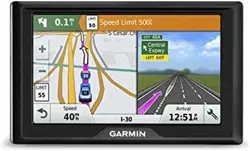Loading ...
Loading ...
Loading ...

4
If there is more than one incident, use the arrows to view
additional incidents.
Customizing the Map
Customizing the Map Layers
You can customize which data appear on the map, such as
icons for points of interest and road conditions.
1
Select Settings > Map & Vehicle > Map Layers.
2
Select the layers to include on the map, and select Save.
Changing the Map Data Field
1
From the map, select a data field.
NOTE: You cannot customize Speed.
2
Select a type of data to display.
Changing the Map Perspective
1
Select Settings > Map & Vehicle > Driving Map View.
2
Select an option:
• Select Track Up to display the map in two dimensions (2-
D), with your direction of travel at the top.
• Select North Up to display the map in 2-D with north at
the top.
• Select 3-D to display the map in three dimensions.
3
Select Save.
Traffic Data
NOTICE
Garmin is not responsible for the accuracy or timeliness of the
traffic information.
Traffic data is not available in all areas or for all product models.
For information about traffic receivers and coverage areas, go to
www.garmin.com/traffic.
To avoid traffic delays, your device must receive live traffic data.
• If your device includes a traffic receiver, it can receive traffic
data from an over-the-air broadcast signal, where available.
• An FM traffic receiver is included in product models ending
with LT or LMT.
• The device must be connected to vehicle power using the
included power cable to receive traffic data using the traffic
receiver.
• The device must be within range of a traffic data signal to
receive information using the traffic receiver.
Receiving Traffic Data Using a Traffic
Receiver
NOTICE
Heated (metallized) windshields could degrade the performance
of the traffic receiver.
If your device includes a traffic receiver, it can receive traffic
data from an over-the-air broadcast signal, where available. This
feature is not available in all areas or for all product models.
1
Verify your device includes a traffic receiver.
• An FM traffic receiver is included in product models
ending with LT or LMT.
2
Connect the device to vehicle power using the power cable
included with your device (Connecting the Device to Vehicle
Power, page 2).
The power cable included with your device includes an
antenna for the traffic receiver.
When you are within a traffic coverage area, your device can
display traffic information and help you avoid traffic delays.
About Traffic Subscriptions
You can purchase additional subscriptions or a renewal if your
subscription expires. Go to http://www.garmin.com/traffic.
Viewing Traffic Subscriptions
Select Settings > Traffic > Subscriptions.
Adding a Subscription
You can purchase traffic subscriptions for other regions or
countries.
1
From the main menu, select Traffic.
2
Select Subscriptions > .
3
Write down the FM traffic receiver unit ID.
4
Go to www.garmin.com/fmtraffic to purchase a subscription
and get a 25-character code.
The traffic subscription code cannot be reused. You must
obtain a new code each time you renew your service. If you
own multiple FM traffic receivers, you must obtain a new
code for each receiver.
5
Select Next on the device.
6
Enter the code.
7
Select Done.
Enabling Traffic
You can enable or disable traffic data.
1
Select Settings > Traffic.
2
Select the Traffic check box.
Using the Apps
Using Help
Select Apps > Help to view information about using the
device.
Searching Help Topics
Select Apps > Help > .
Viewing Previous Routes and Destinations
Before you can use this feature, you must enable the travel
history feature (Device and Privacy Settings, page 12).
You can view your previous routes and places you have stopped
on the map.
Select Apps > Where I've Been.
Customizing the Device
Map and Vehicle Settings
Select Settings > Map & Vehicle.
Vehicle: Sets the icon that represents your position on the map.
Go to www.garmingarage.com for more icons.
Driving Map View: Sets the perspective on the map.
Map Detail: Sets the level of detail on the map. More detail may
cause the map to draw slower.
Map Theme: Changes the color of the map data.
Map Tools: Sets the shortcuts that appear in the map tools
menu.
Map Layers: Sets the data that appears on the map page
(Customizing the Map Layers, page 10).
10 Traffic Data
Loading ...
Loading ...
Loading ...
